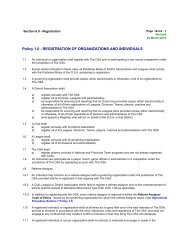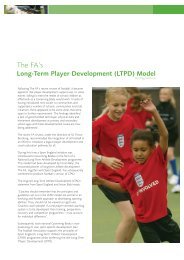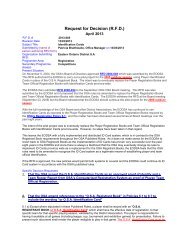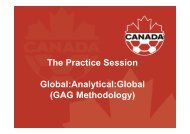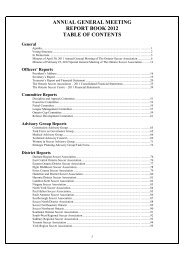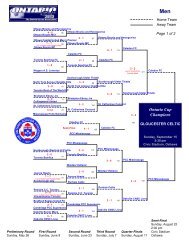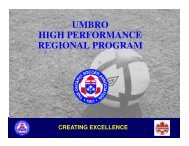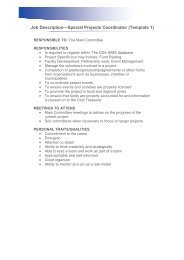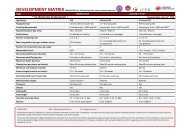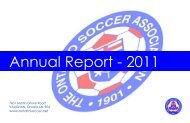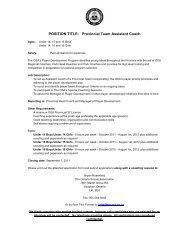LEAGUE MANAGEMENT GUIDE - Ontario Soccer Association
LEAGUE MANAGEMENT GUIDE - Ontario Soccer Association
LEAGUE MANAGEMENT GUIDE - Ontario Soccer Association
- No tags were found...
You also want an ePaper? Increase the reach of your titles
YUMPU automatically turns print PDFs into web optimized ePapers that Google loves.
<strong>LEAGUE</strong> <strong>MANAGEMENT</strong> <strong>GUIDE</strong>:Learning to Train U8 – U121
CONTENTSPurpose . . . . . . . . . . . . . . . . . . . . . . . . . . . . . . . . . . . . . . . . . . . . . 3LTPD Principles . . . . . . . . . . . . . . . . . . . . . . . . . . . . . . . . . . . . . . . . . 3U8-U12 in 2013 . . . . . . . . . . . . . . . . . . . . . . . . . . . . . . . . . . . . . . . . . 4Defining a League . . . . . . . . . . . . . . . . . . . . . . . . . . . . . . . . . . . . . . . . 5Realignment of Leagues from levels. . . . . . . . . . . . . . . . . . . . . . . . . . . . . 6Introduction. . . . . . . . . . . . . . . . . . . . . . . . . . . . . . . . . . . . . . . . . . . 7Process and Responsibilities. . . . . . . . . . . . . . . . . . . . . . . . . . . . . . . . . 7Process for League Entry. . . . . . . . . . . . . . . . . . . . . . . . . . . . . . . . . . . 8We’re a League…How do we tier player pools? . . . . . . . . . . . . . . . . . . . . . . . 9When should we Tier? . . . . . . . . . . . . . . . . . . . . . . . . . . . . . . . . . . . . 10Ongoing Identification and Monitoring . . . . . . . . . . . . . . . . . . . . . . . . . . . 10Who Runs the League?. . . . . . . . . . . . . . . . . . . . . . . . . . . . . . . . . . . . 11Frequently Asked Questions . . . . . . . . . . . . . . . . . . . . . . . . . . . . . . . 12-13Appendix ONE:Sample Club tiering . . . . . . . . . . . . . . . . . . . . . . . . . . . . . . . . . . 14-15Appendix TWO:Timeline . . . . . . . . . . . . . . . . . . . . . . . . . . . . . . . . . . . . . . . . . . . 16Appendix THREE:District League Scenario . . . . . . . . . . . . . . . . . . . . . . . . . . . . . . . . . 17Appendix FOUR:Sample League Application. . . . . . . . . . . . . . . . . . . . . . . . . . . . . . . . 18Appendix FIVE:Competition Review . . . . . . . . . . . . . . . . . . . . . . . . . . . . . . . . . . . . 19Appendix SIX:Playing Up Guidelines . . . . . . . . . . . . . . . . . . . . . . . . . . . . . . . . . . . 202
PurposeWith Long-Term Player Development (LTPD) principlesremoving promotion and relegation from the OSAPyramid of Play for all competitive teams below U13,there is misunderstanding and confusion regardinghow existing District, Multi-jurisdictional and RegionalLeagues are to operate in this new environment.This OSA League Management Guide for Learning toTrain provides a reminder of the Key Principles that guideplaying rules and competition format for organizationsthat operate competitive environments for players agedU8 – U12. When referring to ‘competition’ we advisethat the Game Organization Guide–Physical Literacy(U8-U12) be used in conjunction with this LeagueManagement Guide—Learning to Train (U8 – U12). TheGame Organization Guide identifies appropriate typesof competition at each age. This guide provides somesimple ‘How To’ guidance to help make your league asuccess under LTPD by learning from best practices of anumber of established leagues in Canada and overseas.As the current providers of leagues you know better thananyone the needs in your area, and this document helpsyou make changes based on LTPD principles withoutbeing over prescriptive.In subsequent documents the provision of leaguemanagement for the <strong>Soccer</strong> for Life stage (U13 andabove) will provide guidance for players at that age.LTPD Principles U8-U121. Training to Competition ratio is 2:1 or 3:1. Competition includes formal matches in festival and exhibition game play.2. Physical Development at this stage is a steady growth from around 6 years of age through to the growth spurt at11 or 12.3. Schooling in <strong>Ontario</strong> means at the latter ages of this stage children are entering Grades 6-8 and have academic,social and personal pressures to deal with.4. In these development stages children should be encouraged to participate in a range of sports.“The Football <strong>Association</strong> (England) in its2011 national survey of youth players (8-12)identified that players at this age don’t seebeyond the game itself. A season of 15 gameshas no relevance to them.”Our Game, The FA, 20123
U8-U12 in 2013At the heart of this competition, change is the critical need for our developmental competitive environments tobe effective, engaging and most importantly FUN. U8 – U12 is that fantastic ‘golden age of learning’ and just asrewarding intrinsically for players and coaches alike. Three key principles guide this change in competition andreinforce the philosophy of the player being at the centre of all decisions made.1. No Scores or Standings: Removing promotion and/or relegation within a league or between leagues as well asthe removal of league standings is a paradigm shift in the way we run our leagues. The key outcome for the U8-U12 player as they move from Learning to Train into either the <strong>Soccer</strong> for Life or Training to Train stage will be amarked increase in their technical and tactical ability.2. Principle of self-determination: Clubs can determine what level of play they wish to play at. By providing coachesthe ability to regularly monitor their pool of players, players that they know well, positive changes can be made toensure players are challenged and managed appropriately.3. Principle of re-balancing: Leagues must allow for a Club to move a pool of players to another division allowingthem a chance to play at an appropriate level of competition within a given season.The following changes should result from the leagues’ alignment withthese principles:CURRENT2014Players are constrained by their age and team needslimiting their opportunity to develop appropriately.Players should be playing at a level which isappropriate for their ability, experience, physical sizeand age.A rigid schedule is created that often results inweaker teams losing by large margins and strongteams unchallenged.Leagues must regenerate the league “schedule”after the first few games as pools of players find theirappropriate level. This may be timed to happen overthe Canada Day Weekend or sooner where possible.Talented players are limited by their opportunities tobe challenged by ‘playing-up’ policies.Talented players will be able to play-up on occasionsthat are appropriately managed and monitored. (SeeAppendix 6 for guidance on playing up).Strong teams are able to dominate at their own agegroup and not be challenged.Clubs will now reflect LTPD-based pools of playersand not fixed rosters. It is not encouraged for a wholeteam to move up an age group. As a Club, eachplayer should be allocated to a “tier” based on theirindividual ability level (See Appendix 6 for guidanceon playing up).4
Defining a LeagueThe new league model at each age group from U8 to U12 will provide tiers for ability levels and movement withinthose tiers. It is important that we see these realigned leagues not as systems of promotion/relegation. In fact, a briefreview of league definitions doesn’t refer to promotion/relegation;‘An association of sports teams that establishes rules of play, decides questions of membership in the league, andorganizes matches between the member teams’.Webster Dictionary‘A group of athletic teams organized to promote mutual interests and to compete chiefly among themselves’Dictionary.comThe new league model encompasses those players previously described as Competitive, Rep, Select or All Starplayers who would compete in inter-club competition. By bringing these players together in a development-focusedenvironment we can provide them with every opportunity to achieve their ambitions in soccer and ensure a lifelonglove for the game. Inter-club competition will still exist but the environment will be player and not team focused.Clubs will group players together of a similar ability based on their Tactical, Technical, Physical and Emotional capacityat any given time. The technical leader within the Club (Technical Director, Club Head Coach, etc.) must have thetechnical oversight to ensure player development and enjoyment are the key focus of any player movement and thiswill be assisted by ongoing evaluation of the players in collaboration with Club coaches. Through regular contact withthe Club’s technical leader a coach is then empowered to ensure developing players aren’t left unchallenged.Note:Inter-club recreational leagues provided for Clubs that cannot sustain an in-house league are not the focus of thisguide, but could be reflected with a suitable division in a District league, for example.‘If you have played soccer long enough youhave been the team that was much better thanthe opposition and lost. You have also beenthe team that was outplayed by the oppositionand won. The won-loss record does notaccurately show how the game was played,how players performed or how well the coachprepared the team to play the game’Sam Snow, Director of Coaching, US Youth <strong>Soccer</strong>, 20125
Realignment of Leagues from LevelsThe current structure of soccer in <strong>Ontario</strong> provides for 7 levels of competition. The graphic provides some guidanceon the age groups playing at each level and the league opportunities available for competition for 2014 onwards.This format will assist coaches, players and parents in understanding thelevel of soccer they participate at. The format will also ensure that resourcesare provided for at the appropriate level of the game.‘<strong>Soccer</strong> is an adult game designed by adults for adults to play. Adultsenjoy the game so much that we have shared it with our children. Yetadults err when we bring our adult performance and outcome- basedthinking into the developing player’s world.’Sam Snow, Director of Coaching USYS6
IntroductionThese development leagues will exist for U8-U12 age groups and sit outside of existing recreational soccer leaguesthat are typically known as “house league”. These leagues may be run by a District <strong>Association</strong> or an existing Leagueprovider which will be discussed between the District <strong>Association</strong> and its membership. It will be required of anyleague offering a particular age group to offer both male and female divisions. The OSA Development and RecreationMatrices provide the parameters for competition formats. It is important to recognize that this age range participatesin competition where no scores or standing are kept.Process and ResponsibilitiesCLUBDISTRICTStep 1Expresses an interest to enter the leagueStep 2Expression of Interest acknowledgedStep 3Club confirms player numbers internallyand applies for places in the leagueStep 4Place request acknowledgedStep 7Review, feedback and appeal by ClubsStep 5League assesses all requests acrossage groups, gender and tiersStep 9Coaches appointed to teams(April)Step 6Places identified with ClubsStep 8Places finalizedStep 10Schedules released(May 1)Step 11Season Starts(late May)Step 12Re-balancing in first monthStep 13League program continues(to September)7
Process for League EntryThe OSA has developed a generic League Application Form (Appendix 4) building on best practices currently inevidence and providing flexibility for District <strong>Association</strong> needs. Throughout the application process it is assumed thatDistrict <strong>Association</strong>, Multi-jurisdictional and Regional Leagues will know their Clubs and be aware of:• which clubs can comfortably provide teams in an age group• current field capacity and limitations• struggling teams within a division, and• the optimum number of tiers for their locale. (Example, District A may require one tier at U12 boys where District Brequires 3 tiers at the same age group)This knowledge will assist in drawing up appropriate tiers of ability and provide fluidity in player movement. Tiers:1. Should have between 6 – 8 teams (giving them the ability to play each other twice comfortably).2. If a league has more than 12 teams they should consider tiering or zoning the District (see Point 5).3. Provide maximum player movement within a Club so a Tier 1 player who may need to build confidence, berecovering from injury or be new to the Club can play within a Tier 2 or Tier 3 team of the same Club.4. Vice versa, permit a lower tiered player who is performing well to participate in Tier 1 games.5. Take into account recommended travel time for players within a league. The Development Matrix provides detailson travel times for each age group and District or Multi-jurisdictional leagues can consider an east-west or northsouthzoning to best serve the needs of the player.When applying to enter a league a Club must consider the number of competitive teams they had previously offeredat a particular age.Appendix 1 is an example of a current situation where a Club currently offers competitive teams in a District andRegional league at all of those age groups. In the new format they would identify a Tier 1 and Tier 2 team to beentered into the District League.‘We should measure success NOT by the number of kids who make it toa high level from the Club, but that it should be done on a basis of legacyand enthusiasm. The best argument for success is around numbers ofkids from all levels who want to be involved, have fun and play the game,so the best indication of success is that these kids are involved the nextyear’.Dr. Martin Toms, Senior Lecturer, School of Sport & Exercise Sciences, University of Birmingham8
When should we tier?Tiering is positively encouraged for the 2013 Outdoor Season. It will be mandatory for Clubs and leagues from 2014onwards. If you are preparing to run an LTPD aligned league in 2013 we would suggest the recommended timeline(Appendix TWO) provides appropriate time for tiering to be completed.Club Application for Slots:A Club must apply to the League using a standardized form (Appendix FOUR) that identifies each age group, genderand proposed tier of competition. Clubs must base this on historic registrations for those age groups over past years.The Club will apply for slots based on the number of teams at an age group, gender and ability. Where a Club hasnot entered a team at that age group before, they are able to apply at the tier they feel is appropriate and progressreviewed on an ongoing basis.Ongoing Identification and MonitoringOngoing Identification and Monitoring previously referred to as “tryouts” should not be a situation our playersexperience or get put through until U10. Up until then players play without unnecessary pressure and continue todevelop technical, tactical, physical and social/emotional skills. By the time players reach U12 Technical Directorsshould have an ongoing identification and evaluation process in place that Club coaches can be trained to use. Thisevaluation process should be as stress free as possible for players and crucially:a. Include identification in meaningful competition as well as in training environments.b. Offer open sessions for any player who has a desire to demonstrate their ability to participate within the proposedage group.c. Identify a maximum number of players at each session combined with an appropriate ratio of players to coach(16:1) to provide a more responsible evaluation process.d. Ongoing identification and monitoring should be conducted under the guidance of the Technical Director or ClubHead Coach.‘Our challenge as adults is simple – to help young people fall in love withthe game’The Football <strong>Association</strong>, 201210
Who runs the League?Here are three organizational charts outlining different models for the running of the league. District and MultijurisdictionalLeagues are encouraged to work with a model that suits them best, or a league may choose to developtheir own model. Each model engages the membership slightly differently, but it is important to note the role thatTechnical Directors (District and Club) and Club Head Coaches play in the running of the league.Administration may be run from within the District <strong>Association</strong>, as currently happens in four Districts or it may be runby an existing league.Note:Leagues can and have been built on the focus and passion of Technical Directors within their District <strong>Association</strong>s.While a clear link exists to the District <strong>Association</strong> Board it has helped with the format of each event that thesecommittees are able to make decisions based on player development.11
Who is going to run this league? Do we need to hire staff as this will need to be budgeted for?The league may be run by the District <strong>Association</strong> where a staff member is employed in the office. Additionaltasks have also been picked up by the District Technical Directors. We strongly recommend that an experiencedAdministrator oversees the running of the league with appropriate input to ensure LTPD compliance.We don’t have enough teams at a particular age group to play in our District, what can we do?There are four possible options for you and these need to be discussed actively with the District <strong>Association</strong>. 1. Youcan request the ability to Play Out of your District; 2. See if there is potential for your District League to work with aneighbouring District to offer specific age groups; 3. Play up in the lowest tier of a higher age division or 4. Play downan age group in the highest tier of a lower age group.How many fields are Clubs going to need to accommodate so many players?There are excellent examples of efficient field use. For example, multiple micro and mini pitches can beaccommodated on one full-sized field. Remember that festival formats on weekends will require most space. Outsideof the festival format they’re not on weekends so little will change.How do we know we have the technical criteria aligned with LTPD principles?Technical Directors and Club Head Coaches in Clubs will be well aware of LTPD implementation across <strong>Ontario</strong>. ADistrict <strong>Association</strong> can create a Technical Committee to lead the technical requirements of the league.Where do players go after U12?This is a very common question and requires a detailed explanation. Up to U12 the focus has been on development,giving each child the maximum opportunity to grow as a player. The majority of players will then move into thecompetitive stream that will take them through to adult leagues and beyond. Others will move into the OPDLenvironment. More information on this environment will be coming shortly.How many Leagues can a District <strong>Association</strong> sanction?District <strong>Association</strong>s should work on the assumption that each age group (U8-U12) is provided for with a male andfemale division of 1-3 tiers each. It is then at the District <strong>Association</strong>s’ discretion whether the District should be splitdue to geographic size. In such a situation for example a U12 Northern Tier 1,2 and 3 and U12 Southern Tier 1,2, and3. Appropriate competition weekends may allow these Clubs to cross over during the season.How many players can we have on our roster at each game?As per the Development Matrix the following is required:U8: Maximum of 10U9/U10: Ideal 9, maximum of 12U11/U12: Ideal 12, maximum of 16When would we hold try outs?We now refer to try outs as “Ongoing Identification and Monitoring”. Stand-alone events are no longer required. If theindoor season is used for development purposes then players can be pooled, developed and assessed through thewinter months. As the outdoor season approaches the Club will have been able to monitor player progress and ability.Can a player play up and on their own team on the same day?Provided that they do not exceed the maximum time identified within the matrices for their age. For example, if aplayer is U8 (30-45minutes max.) they can play up to the U9 team and on their own team on the same day as longas their playing time does not exceed the time outline for U8. They cannot play up to the U9 playing time of 45-70minutes.13
Appendix ONEThis example shows Club A and Club B in <strong>Ontario</strong>. Club A is a large Club that offers many recreational teams as wellas some current competitive teams at the District and Regional level. They have made the assumption that theseteams will continue at this type of level for 2013 and have applied to their local District and Multi-jurisdictional leaguesfor similar places this coming season. The table reflects where multiple teams currently run in an age group andassuming they will continue in 2013 as player pools, as opposed to teams.Club A (Large)Gender Age Group In 2012 In 2013Male U12 (2000) CESL L41A U13 Regional/District/ClubU12 (2000) CSL L3 U13 Regional/District/ClubU11 (2001) CESL U12 CESL Tier 1-3U11 (2001) CESL U12 CESL Tier 2-3U10 (2002) CESL U11 CESL Tier 1-3U10 (2002) CESL U11 CESL Tier 2-3U9 (2003) District League U10 District League Tier 1-3U9 (2003) District League U10 District League Tier 2-3U8 (2004) District League U9 District League Tier 1-3U8 (2004) District League U9 District League Tier 2-3U7 (2005) Within Club program U8 District League Tier 1-3Female U12 (2000) CGSL U13 Regional/District/ClubU12 (2000) CGSL U13 Regional/District/ClubU11 (2001) CESL U12 CESL Tier 1-3U11 (2001) CESL U12 CESL Tier 2-3U10 (2002) CESL U11 CESL Tier 1-3U10 (2002) CESL U11 CESL Tier 2-3U9 (2003) District League U10 CESL Tier 1-3U9 (2003) District League U10 CESL Tier 2-3U8 (2004) District League U9 CESL Tier 1-3U7 (2005) Within Club program U8 District League Tier 1-314
Club B is a medium sized club that offers fewer teams playing competitively at each age group. They will follow thesame process and assume all their teams will continue to play competitively in 2013.Club B (Medium)Gender Age Group In 2012 In 2013Male U12 SRSL Division 3 Regional/District/ClubU11 SRSL Premier HMJDCSL Tier 1U11 SRSL Division 1 HMJDSCL Tier 2U10 HMJDSCL Premier HMJDCSL Tier 1U9 HMJDSCL HMJDSCL Tier 1-3U7 Within Club program District League or HMJDSCL Tier 1-3Female U12 SRSL First Regional/District/ClubU11 SRSL Premier 1U10 HMJDSCL HMJDSCL Tier 1-3U9 HMJDSCL HMJDSCL Tier 1-3U7 Within Club program District League or HMJDSCL Tier 1-315
Appendix TWOKey DateNovemberDecember 14 2012January 18 2012March 1 2013March 15 2013March 29 2013AprilMay 3 2013TaskLeague AGM – present new formatSurvey existing leagues and Clubs for readiness and interestLeague Application provided to all ClubsClub Applications for Team Slots deadline (PHDL is Feb 17, SCARDESO is April 27th)League Review and draft League w/ TiersLeague Tiers finalized and announcedClubs prepare Coaches and Managers Host Coach Education Courses for complianceSchedules distributedMay 25 2013 Season Kick Off (Match Day 1)June 1 2013 Match Day 2June 8 2013 Match Day 3June 15 2013 Match Day 4June 17-19 2013June 20-21 2013Realignment Panel sittingJune 22 2013 Match Day 5June 29 2013July 6 2013 Match Day 6July 13 2013 Match Day 7July 20 2013 Match Day 8July 27 2013 Match Day 9August 3 2013August 10 2013 Match Day 10August 17 2013 Match Day 11August 24 2013 Match Day 12August 31 2013September 7 2013 Match Day 13September 16 2013 Match Day 14September 23 2013 Match Day 15Realigned Schedules distributedCanada Day Weekend –No GamesCivic Holiday – Tournament WeekendLabor Day Weekend – Tournament WeekendNotes regarding the timeline1. Long weekends have been blocked out for family time. However, flexibility in squad movement allows for playersto move if a particular weekend is lower in participants.2. Leagues should consider the use of artificial surfaces or domes at the start and end of the season to maximize theseason length. Please refer to the Development Matrix for further details.3. Leagues are encouraged to host Coach and Manager Sessions as well as Parent Information Evenings prior tothe season start.4. The dates identified as game days are Saturdays for example purposes only.16
Appendix THREEDistrict Situation 1District A currently has a league running for U8, U9 and U10 age group teams (male and female). In 2013:a) These age groups will move on to create U9, U10 and U11 age groupsb) U8 will also be created again with the U7’s from 2012c) The League will also add the U12 age group by drawing down the U12 age group from its related Regionalleague.DistrictLeagueU12 (drawn down fromRegional League)U9(existing)U11(existing)U10(existing)U8(from Club environment)District Situation 2District B has no league running at any age groups:a) Creates divisions for U8, U9, U10 players, consider collaboration with neighbouring District <strong>Association</strong>b) Assess provision by local Regional league to draw down U11 and U12 teams17
Appendix FOUR: Sample League Application2013 U8-U12 Player Development League Application FormApplication Deadline: 12 Noon, March 1st, 2013FULLY completed application form must be submitted by your Club with all Entry Fees payable byCLUB CHEQUE ONLY and sent to: District Address, Town, Postal Code.Age Group: Year of Birth: Gender: Tier Request:TEAM INFORMATIONTeam Name:Team Number:Team Manager:Address:City:Postal Code:Phone (Home):Fax Number:Email:CLUB INFORMATIONTeam Name:Team Number:Team Manager:Address:City:Postal Code:Phone (Home):Fax Number:Email:COACHName:Address:City:Postal Code:Phone (Home):Phone (Work):OSA Registration No.:Email:Respect in Sport No.:Coaching Level:Laws of the Game:HOME FIELDPark Name:Address:City:TEAM OFFICIALS INFORMATIONASSISTANT COACHName:Address:City:Postal Code:Phone (Home):Phone (Work):OSA Registration No.:Email:Respect in Sport No.:Coaching Level:Laws of the Game:FIELD SCHEDULERPark Name:Address:City:Date Paid: Cheque# Club or Personal Cheque (circle) Staff Initials:18
Appendix FIVE: Competition ReviewOften a game of soccer forces children to conform to adult norms rather than making the game relevant and realisticto the child. The introduction of Mini <strong>Soccer</strong> to <strong>Ontario</strong> in 2006 challenged our conventional thinking of the game forplayers U10 and younger. This document in conjunction with the ‘OSA Game Organization Guide’ provides the nextlogical step in that progression for players U8-U12.The following areas have been identified by the Canadian Sport 4 Life Expert Group to assist Leagues, Clubs and<strong>Association</strong>s in the reflection and assessment of their competitions. From the CS4L Provincial Scorecard;‘All sport organizations support competition but not all put effective policies and programs in place to support theintentional use of competition. Competition programs support CS4L objectives when policies ensure periodized,developmentally appropriate, meaningful competition at quality events, and when competitions are affordable andaccessible and enhance system alignment between national, provincial and community sport organization goals.’This CS4L table identifies the 11 criteria by which competition can be assessed in its relations to intentional anddevelopmentally appropriate competition.19
Appendix SIX: Playing Up Guideline<strong>Ontario</strong> <strong>Soccer</strong> <strong>Association</strong> and its Player Development model support the philosophy of continuing to challengeits member players. Players that choose to be considered for potentially playing up an age group must meet thefollowing guidelines for selection:Technical AbilityA player must demonstrate a high degree of individual skill which must be transferable to competitive participatingplayers within the age group the player wishes to participate in.Playing Time GuidelineIt is required that teams implement an equal or minimum playing time policy for those participating under age players.This guideline should be subject to the discretion of the coaching staff as it pertains to the health, safety and eligibility(code of conduct) of the individual player. (This policy is as per the Canadian <strong>Soccer</strong> <strong>Association</strong>’s LTPD Model)• Under 6 to Under 12 - equal playing timePhysical AbilityA player must meet or exceed other players within their age group in physical strength, technical skill and speed, andhave the ability to blend in with players of the intended age group.Mental AbilityPlayer must meet or exceed other players within their age group in game awareness and general knowledge ofthe game. To include the mental strength that will be necessary when dealing with older and physically superioropponents.Social AbilityPlayer must be able to interact with players within the intended age group on and off the field (games, dressing room,training and social gatherings).The selection of an underage player will ONLY be supported by the <strong>Ontario</strong> <strong>Soccer</strong> <strong>Association</strong> if the player meetsthese guidelines. These guidelines have been developed to address individual player circumstances to ensure thatspecific windows of trainability are not missed; adherence to LTPD’s national game structure; and to temper coach/parent aspirations of a player’s perceived development.Only in exceptionally rare cases a team may be afforded the opportunity to play up although each member of thesquad must be evaluated for their readiness as described above. It is recommended that this evaluation occurs on aweekly basis and it should not be assumed as the right environment for the group.Playing up is rare in these development stages and if not managed well can be detrimental to playerdevelopment. Decisions should be made by qualified Technical Directors or Club Head Coaches.Other OSA resources availableOSA Game Organization Guide - Physical Literacy (U8-U12)Development Matrices (Recreation and Development)A Guide to Festivals in <strong>Ontario</strong>



